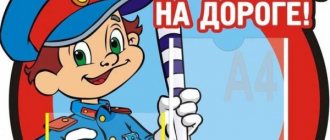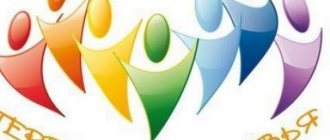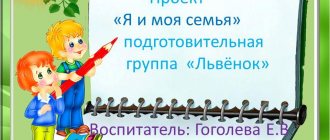Project on traffic regulations “Children and the Road”
Appendix 2
Conversation “Rules for pedestrians and passengers.”
Target:
familiarizing children with the rules for pedestrians and passengers.
Objectives:
- to reinforce with children the concepts of “driver” and “pedestrian”;
- develop children’s horizons and logical thinking, memory, reasoning, speech; - continue to develop a sense of responsibility for your life. Progress of the conversation:
Educator: Children, I want to start our conversation with the proverb: “Beware of troubles while they are not there.”
What do you think the proverb says? (children's answers) Children, what does the word “rules” mean? Can any of you explain to me? (children's answers) Educator: There are rules in the games that we play with you on a walk. There are rules of conduct in the theatre, cinema, and hospital. What other rules can you remember? (children's answers). Educator: I know that there are rules in every family. Maybe you can tell us about the rules in your family? (children's answers) Educator: Rules are a certain order. This means that the important thing for all these rules is that they must be followed. And today we will get acquainted with new rules for you. These rules will help you save life on the roads of our city. And these rules are called rules for pedestrians. There are also rules for drivers. And if drivers and pedestrians strictly follow their rules, then there will be no accidents. And when you grow up, you will learn the rules for drivers yourself in order to drive your own car or work as a driver. Pedestrian rules: Pedestrians must walk on the sidewalk or walkways. If they are absent - along the side of the road, towards moving traffic. When driving along the side of the road or the edge of a road in the dark, you must have objects with reflective elements with you. (the teacher shows children's clothes and objects with these effects). If there is no crossing or crossing in sight, you can cross the road at right angles to the side of the road where it is clearly visible. You cannot cross the road when entering it because of vehicles standing on it. You must cross the road quickly, without stopping on it. If you do not have time to cross a two-way road, you must stop at the dividing line and wait for a safe moment to cross further, if the traffic is not regulated by a traffic light or a traffic controller. Pedestrians are required to give way to special vehicles. (ambulance, police) It is necessary to cross the roadway using a pedestrian crossing (underground and overground). If they are absent, at intersections along the sidewalks or roadsides. Physical education
The guard stands stubborn (Walking in place).
He waves to people: Don't go! (Move your arms to the sides, up, to the sides, down) Here the cars drive straight (Hands in front of you) Pedestrian, you wait! (Hands to the sides) Look: he smiled, (Hands on his belt, smile) Invites us to go. (We walk in place) You cars, don’t rush, (Clapping hands) Let the pedestrian pass! (Jumping in place) Passenger rules
If there are seat belts in a vehicle, they must always be fastened.
When riding a motorcycle, you must wear a motorcycle helmet and fasten it. Wait for public transport at special stops. If they are not there, then on the sidewalk or curb. Passengers are prohibited from: Opening vehicle doors while driving. Drive a truck along with cargo. Talk to the driver while the vehicle is moving. Don't distract the driver! For an accident, a moment is enough. Remember, friends, you cannot distract the driver from driving. Educator: Now we’ll play with you. Game "Fast Drivers".
A typewriter is tied to a medium-length rope at one end and a pencil at the other. Team members need to wind a rope with a machine around a pencil as quickly as possible. Educator: Our journey to the country of traffic rules has ended. You have proven yourself to be competent, knowledgeable pedestrians. And I would like to remind you guys once again: Be careful all the time, And remember in advance: The driver and the pedestrian have their own rules.
Project on traffic rules in the senior group “Traffic Light”
Author: Belyaeva Tatyana Mikhailovna
Project on traffic rules in the senior group “Traffic Light”
Project type: information-practical-oriented.
Project duration: long-term
Project participants: children, parents, teachers of senior group No. 4 “Jolly guys”.
Relevance of the topic: According to statistics, most often the cause of road accidents is children themselves. Children are very excitable, dynamic and at the same time absent-minded, they do not know how to foresee danger, correctly assess the distance to an approaching car, its speed and their capabilities. Preschool children are a special category of pedestrians. Responsibility for raising competent and adequate road users rests with parents and educators. It is known that habits established in childhood remain for life, therefore one of the important problems in ensuring road safety is the prevention of children's road injuries in preschool institutions. Accordingly, the study of the Rules of the Road is one of the main tasks today, and work on a project dedicated to the study of the Rules of the Road will contribute to this.
Goal: to develop in children the skills of conscious safe behavior on the roads.
Tasks:
• Assimilation by preschoolers of initial knowledge about the rules of safe behavior on the street.
• Develop skills of a conscious attitude towards compliance with safe traffic rules and rules for passengers.
• To consolidate knowledge about the operation of traffic lights.
• Clarify and consolidate knowledge about various types of transport.
• Prepare for the correct actions in the current situation on the road or street.
• Intensify joint activities of parents and children.
Expected result:
Children’s development of elementary knowledge and ideas on the topic “Road Rules” in accordance with their age.
Development of skills for behavior on the street and in public transport;
Enrichment of the subject-development environment according to traffic rules in the group;
Increasing the interest of parents in the problem of teaching children road literacy and safe behavior on the road;
Activation of joint activities of kindergarten and family in matters of safety.
Stages of work on the project:
Preparatory stage:
1. Study and analysis of children’s knowledge level on the topic.
2. Selection of methodological literature on the topic.
3. Selection of fiction and Internet resources.
4. Examination of drawings and photographs about road situations.
5. Making educational games based on traffic rules.
6. Production of travel folders according to traffic regulations, consultation “For parents about traffic rules.”
Main stage of work:
1. Observations: “What we saw on the street”
2. Conversations: “If you leave the house - be careful”, “Pedestrian crossing”, “Family transport”, “My street”.
3. Lessons: “You need to obey the traffic light instructions without arguing,” “My favorite car,” “I draw the road,” “Zebra” sculpting.
4. Reading fiction: S. Mikhalkov “Traffic Light”, “Bad History”, M. Plyatskovsky “Traffic Light”, A. Severny “Three Wonderful Colors”, Y. Pishumov “ABC of the City”, “It’s just such a sign...”, “Sentryman”, “Grocery car”, O. Bedarev “If…”, N. Nosov “Car”, V. Golovko “Traffic rules”, etc.
5. Didactic games: “Guess the transport”, “Play and be smart!”, “Think - guess!”, “Merry rod!”, “Rush hour”, “Collect traffic situations”, “Teach Dunno the traffic rules”, “What will happen , If…"
6. Outdoor games: “Sparrows and a car”, “Colored cars”, “Dexterous pedestrian”, “Pedestrians and transport”, etc.
7. Game-dramatization “Traffic Controller”.
8. View and discuss the cartoon “Smeshariki teach traffic rules.”
The final stage:
• Entertainment “Everyone should know the rules of the road!”
Methodological literature:
• E. Ya. Stepanenkova, M. F. Filenko “For preschoolers about the rules of the road”;
• Poddubnaya L. “Road rules for the middle group.”
• Avdeeva, N. N. Safety on the streets / N. N. Avdeeva. M.: LLC Publishing House AST-LTD, 2003.
• Agafonova, K.V. Children and traffic / K.V. Agafonova. - M.: Education, 2001.
• Boguslavekaya Z. M. Educational games for children of primary preschool age / Z. M. Boguslavekaya, E. O. Smirnova. M.: Education, 2003.
• Dorokhov, A. A. Green, yellow, red / A. A. Dorokhov. - M.: Children's literature, 2002.
• Klimenko, V. R. Teach a preschooler the rules of movement / V. R. Klimenko. - M.: Education, 2007.
• Saulina T.F. Three traffic lights: Familiarization of preschoolers with the rules of the road: For working with children 3-7 years old.
– M.: MOSAIKA-SYNTHESIS, 2010. – 112 p. : color on comments powered by HyperComments
Long-term project on traffic rules for the senior group “Safe road for you and for me”
Svetlana Alexandrova
Long-term project on traffic rules for the senior group “Safe road for you and for me”
Project : “ Safe road for you and me ”
Project duration : long-term
Type of project : educational and research
Dates: September - May 2016-2017
Participants: senior , parents
Goal: Continue to familiarize children with the rules of the road ; to clarify and expand children’s knowledge about the elements of the road , about traffic, about safe behavior on the streets of their hometown; the formation of personal qualities: attention, responsibility for one’s behavior - confidence in one’s actions. Develop logical thinking, attention, imagination, observation; Systematize children's knowledge about traffic rules by playing out problem situations.
Tasks:
• Continue to become familiar with traffic rules, traffic rules for pedestrians and vehicle passengers;
• develop logical thinking;
•develop mental functions: analysis, comparison, observation, imagination, creativity;
• activate and enrich children's vocabulary on the topic;
• instill safe behavior skills on the roads of your hometown ;
• cultivate a culture of behavior on the roads ;
• improve the ability to navigate in the surrounding space;
• involve parents in joint activities with children.
Relevance of the project
The need to teach children traffic rules, since children often cause accidents. Teaching preschoolers traffic rules is an important task for an adult. After all, the situation with children’s road traffic injuries was and remains very alarming.
A child who finds himself on the street can automatically be considered in danger. Road traffic accidents are the most common cause of death among children
street, and traffic accident injuries are the most severe. Soon there will come a time in the life of the family when the child goes to school. This stage of his life will be associated with a number of problems, of which the most acute are the problems of child safety on the road . So the task of teachers and parents is to prepare him to face various difficult and sometimes dangerous situations on the road , to instill in the child the skills of correct behavior on the street. After all, only those who receive the necessary knowledge about existing dangers, learn to recognize them in a timely manner, and avoid them can help themselves in a difficult situation. The relevance of this problem is also due to the fact that preschool children do not have that protective psychological reaction to the environment that is characteristic of adults. Therefore, ensuring the safety of children on the streets and roads , preventing child road traffic injuries is one of the most pressing tasks that requires immediate solution .
Expected results for the project
For children:
• children’s ability to independently conduct basic research;
• use of vivid, figurative expressions in speech that characterize the safety of traffic rules ;
• understanding the cause-and-effect relationships of traffic rules;
• gaining in-depth knowledge of traffic rules.
For parents:
• expanding opportunities to influence the processes of raising children;
• become involved in the life of children within a preschool institution;
• build relationships with children
For the teacher:
• knows a variety of ways and methods of enriching children's knowledge about traffic rules;
• a card index of games, riddles, and poems about traffic rules has been prepared.
Project implementation stages
Organizational stage
Tasks of the first stage:
1. Determine the topic, purpose and objectives of the project ;
2. Determination of the necessary technical, information and methodological resources;
3. Theoretical justification of methods and forms of education according to traffic rules;
4. Formation of a strategy for the project .
5. Preparation of information for parents.
Activities of teachers Activities of children Activities of parents
Selection of games for children:
Didactic
Mobile
Role-playing
Logical tasks Get acquainted with new games, express your emotions (what you like)
Conducting conversations to obtain information about the level of awareness of preschoolers about traffic rules. Talk about their observations.
Selection of works of fiction, riddles, sayings, proverbs about the rules of behavior for children on the roads . Select illustrations for fairy tales about cars, roads , road signs ;
selection of cartoons on the topic
Conclusion: as a result of the joint work of all project , the goals and objectives of the project , the forms and methods of work were determined, and an information base was prepared on the topic “ A Safe Road for You and Me ”
https://nsportal.ru/detskii-sad/raznoe/proektnaya-deyatelnost-v-dou-2https://nsportal.ru/detskii-sad/raznoe/proektnaya-deyatelnost-v-dou-2Practical stage
Second stage tasks:
1. Develop skills to conduct targeted observation;
2. Develop the ability to conduct research, observations and establish cause-and-effect relationships;
3. Develop creative abilities by making illustrations for the stand, road signs in the process of productive activities;
4. Develop professional self-awareness of teachers;
5. Contribute to the optimization of relations between children and parents;
6. Expand the theoretical knowledge of parents within the framework of the issue of instilling a culture of behavior on the roads of their hometown .
Activities of teachers Activities of children Activities of parents
Conducting conversations about traffic rules, drawing up problem situations about road safety . Solving problematic problems, answering questions.
Organization of game activities on the problem Comprehend and establish cause-and-effect relationships about safety on the roads of their hometown , try on the roles of road , put forward their assumptions Organize joint games and discussion of situations on the roads , sidewalks in transport
Conducting an excursion to the road. They learn poems about traffic rules, road signs , demonstrate creativity when practicing the roles of characters. Prepare flags and vests.
Demonstration of paintings, illustrations on the topic
Examination of cars, traffic lights, roadways , compilation of descriptive stories Selection of demonstration material
Reading fiction, proverbs, sayings, riddles, traffic rules Consider the behavior and actions of characters in fairy tales, demonstrate their solutions to problem situations, express sympathy and antipathy for the heroes of works, use figurative expressions in speech, use terms on the topic in speech Consider the participants with children traffic
Making applications, drawings Make efforts, show creativity, imagination, display plots of works, observations Make games and attributes together with children
Creating a "base"
fleet,
road signs Collecting vehicles, traffic lights, road signs Together with children, collecting attributes for games
Compiling a card index of games, observations of transport and roadways , riddles, poems, crosswords Observing transport, roadways , traffic lights, passers-by, drawing conclusions, conclusions , analysis Observe traffic rules participants with children, talk about what they saw
Replenishment of the corner for parents with questions:
— “Is it easy to teach a child to follow traffic ”
— " safety is in our hands"
;
— “Teaching children to be observant on the street”
Get acquainted with information, consult with a teacher
Organizing a corner about traffic rules Looking at illustrations, postcards, games Selection of material for a safety
Selection of fairy tales and poems about traffic rules Get acquainted with interesting facts on the roads through fairy tales
The final stage
Objectives of the third stage:
1. Summarize the results of the pedagogical project ;
2. Prepare and present a presentation to teachers and parents within the framework of the MBDOU on the results of the project ;
3. Prepare a file of observations of transport and pedestrians; riddles, poems, rules of behavior on the roads of your hometown .
4. Organize a corner according to traffic rules
Activities of teachers Activities of children Activities of parents
Self-assessment of the results of the pedagogical project
Presentation of the project Familiarization with the results of joint activities within the project
Making card files
- observations
- games
- riddles, poems
— media sounds of special vehicles
Presentation on the topic of the project Review the results of their work Involving children in activities within a preschool institution
Pedagogical project “ Safe road for you and me ”
allowed to generalize and deepen the knowledge of preschoolers about the rules
of safe behavior on the roads of their hometown . Children had the opportunity to actively participate in observations of the roadway , as a result of which they drew conclusions.
Causal relationships were established. In the process of productive activity, they showed creativity, imagination, and previously acquired skills. Parents, during the implementation of the project , took part in joint activities with their children.
It should be noted that the expected results were achieved:
For children:
• Became observant, enthusiastic, and take initiative in experimental activities;
• When describing transport, situations on the roads , composing creative stories, in speech they use synonyms, antonyms, definitions (public, safe , convenient, moving, transportation, etc., figurative expressions characterizing safety and traffic participants;
• Understand and can explain cause-and-effect relationships according to traffic rules;
• Gained in-depth knowledge about a safe road for themselves and their comrades.
For parents:
• Got the opportunity to show their creativity and imagination;
• Became involved in the life of children within the preschool;
• Established relationships with children, determined the direction of work for the future.
For the teacher:
• knows a variety of ways and methods of enriching children's knowledge about traffic rules;
• a card index of observations on traffic rules, games, a media library of sounds of special transport, a film library, works of art has been prepared, a subject-development environment on traffic rules has been created






